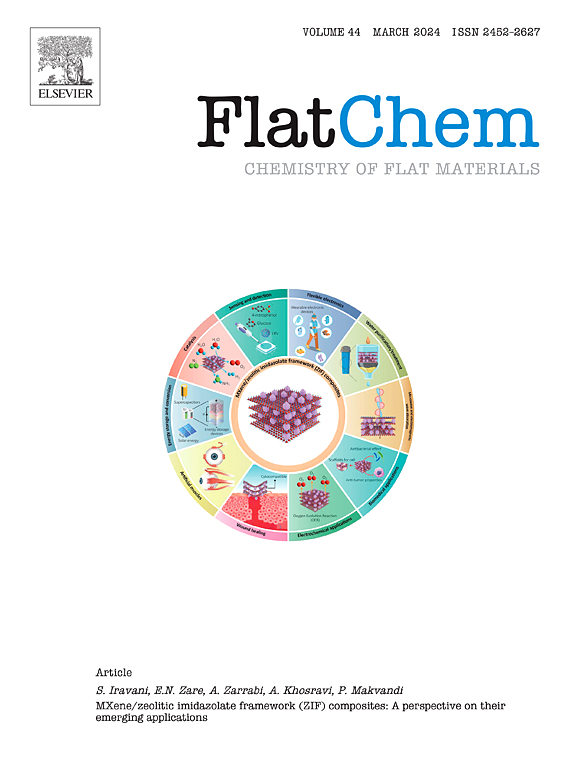ocd -石墨烯:一种具有高钠离子电池理论容量的二维碳同素异形体
IF 6.2
3区 材料科学
Q2 CHEMISTRY, PHYSICAL
引用次数: 0
摘要
采用密度泛函理论(DFT)模拟系统研究了新设计的八角形扭曲二维(2D)材料ocd -石墨烯作为钠离子电池(sib)阳极的性能。声子色散和从头算分子动力学(AIMD)计算证实,ocd -石墨烯单层具有强大的动态和热稳定性。该结构表现出明显的力学响应,符合Born-Huang稳定准则。单个Na原子优先结合在ocd -石墨烯的八边形扭曲环上,其吸附能(Eads)为−1.64 eV。全钠化结果(24个Na原子)产生1339 mAh/g的显著容量,优于许多传统的阳极材料。Eads在- 1.49 eV到- 0.58 eV之间,表明Na与薄膜的相互作用良好,电荷转移适宜。AIMD仿真验证了该系统在300k时的稳定性。此外,钠离子在ocd -石墨烯上的迁移势垒为0.12 eV,扩散速率高(D≈9.72 × 10−3)。在合适的开路电压范围(1.49 ~ 0.40 V)内验证了Na电极的电化学稳定性。这些发现突出了ocd -石墨烯作为sib高性能阳极材料的潜力,为进一步的研究铺平了道路。本文章由计算机程序翻译,如有差异,请以英文原文为准。

OCD-graphene: a 2D carbon allotrope with high theoretical capacity for sodium-ion batteries
The performance of the newly designed octagonal-distorted two-dimensional (2D) material, named OCD-graphene, as an anode for sodium-ion batteries (SIBs) is systematically studied using density functional theory (DFT) simulations. The OCD-graphene monolayer exhibits robust dynamic and thermal stability, confirmed by phonon dispersion and ab initio molecular dynamics (AIMD) calculations. This structure shows a significant mechanical response, following the Born-Huang stability criteria. The single Na atom preferentially binds to the octagonal-distorted ring of OCD-graphene with an adsorption energy () of −1.64 eV. Full sodiation results (24 Na atoms) yielding a remarkable capacity of 1339 mAh/g, superior to many traditional anode materials. The ranges from −1.49 eV to −0.58 eV, indicating favorable Na interaction with the sheet and suitable charge transfer. AIMD simulations confirm the stability of the system at 300 K. Additionally, Na mobility across OCD-graphene is facilitated by a low migration barrier of 0.12 eV and a high diffusion rate (D ≈ 9.72 × 10−3). The electrochemical stability of the Na electrode is verified within a suitable open circuit voltage range (1.49–0.40 V). These findings highlight the potential of OCD-graphene as a high-performance anode material for SIBs, paving the way for further research.
求助全文
通过发布文献求助,成功后即可免费获取论文全文。
去求助
来源期刊

FlatChem
Multiple-
CiteScore
8.40
自引率
6.50%
发文量
104
审稿时长
26 days
期刊介绍:
FlatChem - Chemistry of Flat Materials, a new voice in the community, publishes original and significant, cutting-edge research related to the chemistry of graphene and related 2D & layered materials. The overall aim of the journal is to combine the chemistry and applications of these materials, where the submission of communications, full papers, and concepts should contain chemistry in a materials context, which can be both experimental and/or theoretical. In addition to original research articles, FlatChem also offers reviews, minireviews, highlights and perspectives on the future of this research area with the scientific leaders in fields related to Flat Materials. Topics of interest include, but are not limited to, the following: -Design, synthesis, applications and investigation of graphene, graphene related materials and other 2D & layered materials (for example Silicene, Germanene, Phosphorene, MXenes, Boron nitride, Transition metal dichalcogenides) -Characterization of these materials using all forms of spectroscopy and microscopy techniques -Chemical modification or functionalization and dispersion of these materials, as well as interactions with other materials -Exploring the surface chemistry of these materials for applications in: Sensors or detectors in electrochemical/Lab on a Chip devices, Composite materials, Membranes, Environment technology, Catalysis for energy storage and conversion (for example fuel cells, supercapacitors, batteries, hydrogen storage), Biomedical technology (drug delivery, biosensing, bioimaging)
 求助内容:
求助内容: 应助结果提醒方式:
应助结果提醒方式:


